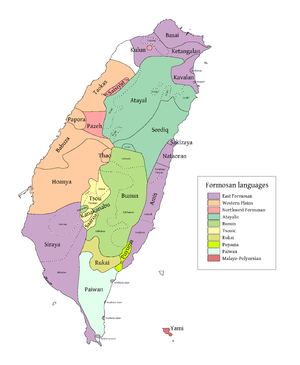Basay language
| Basay | |
|---|---|
| Native to | Taiwan |
| Ethnicity | Basay, Qauqaut |
| Extinct | mid-20th century |
| Dialects |
|
| Language codes | |
| ISO 639-3 |
byq |
| Glottolog |
basa1287[1] |
|
(dark green, north) The Kavalanic languages: Basai, Ketagalan, and Kavalan | |
Basay was a Formosan language spoken around modern-day Taipei in northern Taiwan by the Basay, Qauqaut, and Trobiawan peoples. Trobiawan, Linaw, and Qauqaut were other dialects (see East Formosan languages).
Basay data is mostly available from Erin Asai's 1936 field notes, which were collected from an elderly Basay speaker in Shinshe, Taipei, as well as another one in Yilan who spoken the Trobiawan dialect (Li 1999). However, the Shinshe informant's speech was heavily influenced by Taiwanese, and the Trobiawan informant, named Ipai, had heavy Kavalan influence in her speech.
Syntax
There are four optional case markers in Basay (Li 1999:646).
- a - nominative, ligature (Shinshe dialect)
- ta - nominative (Trobiawan dialect)
- li - locative (Shinshe dialect)
- u - oblique (Trobiawan dialect)
Some function words include (Li 1999):
- pai 'future'
Trobiawan negators include (Li 1999):
- mia 'not' (Shinshe dialect: mayu 'not (yet)')
- asi 'don't' (Shinshe dialect: manai 'don't')
- (m)upa 'not to want'
- (Shinshe dialect: kualau 'not exist')
Yes-no questions are marked by u ~ nu (Li 1999:657).
Morphology
Basay verbs, like Kavalan verbs, distinguish between agent-focus (AF) and patient-focus (PF) verbs (Li 1999:650). The perfective prefixes na- and ni- are allomorphs.
| Type of prefix | Neutral | Perfective | Future |
|---|---|---|---|
| Agentive focus (AF) | -um-, m- | na-mi- | -um- ... -a, m- ... -a |
| Patient focus (PF) | - | ni- | -au |
| Locative focus (LF) | -an | ni- ... -an | -ai |
Pronouns
The Basay pronouns below are from Li (1999:639).
| Type of Pronoun |
Neutral | Nominative | Genitive | Oblique |
|---|---|---|---|---|
| 1s. | yaku | kaku, -ku | maku-, -aku; naku, -ak | yakuan, kuan, kuanan |
| 2s. | isu | kisu, -su | misu, -isu; nisu, -su ~ -is | isuan, suan, isuanan, suanan |
| 3s. | - | -ia | - | - |
| 1p. (incl.) | mita | kita, -ita | mita, -ita; nita, -ta | ...., ...., tianan |
| 1p. (excl.) | yami | -mi | yami, -ami; nami, -am | yamian, mian, mianan |
| 2p. | imu | kimu, -mu | -imu; nimu, -im | imuan, ...., imuanan |
| 3p. | - | -ia | - | - |
References
Notes
- ↑ Hammarström, Harald; Forkel, Robert; Haspelmath, Martin; Bank, Sebastian, eds. (2016). "Basay". Glottolog 2.7. Jena: Max Planck Institute for the Science of Human History.
General references
- Li, Paul Jen-kuei (1999). Some problems in the Basay language. In Zeitoun, E., & Li, P. J-K., Selected Papers From the 8th International Conference on Austronesian Linguistics. Taipei, Taiwan: Academica Sinica.
- Inō Kanori [伊能嘉矩] & Yang Nanjun [楊南郡] (trans). 2012. Research trips among the Plains Aborigines: Selections from Inō Kanori's Taiwan diaries [平埔族調查旅行: 伊能嘉矩<台灣通信>選集]. Taipei: Yuanliu Press [遠流出版公司]. ISBN 9789573268932


